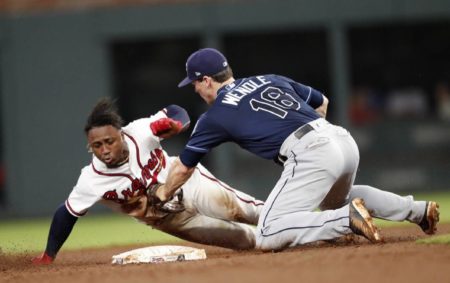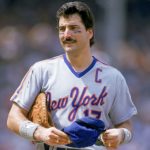Should the Yankees Be More Like the Rays?
 Recent baseball articles about the abrupt end of the Yankees 2018 season questioned the Yankees desire to win. The articles suggested their primary concern was to remain under the luxury tax threshold of $187 million dollars set for 2018. The question was, was Yankees ownership more concerned with saving money than acquiring the right players?
Recent baseball articles about the abrupt end of the Yankees 2018 season questioned the Yankees desire to win. The articles suggested their primary concern was to remain under the luxury tax threshold of $187 million dollars set for 2018. The question was, was Yankees ownership more concerned with saving money than acquiring the right players?
By keeping payroll below $187 million, the Yankees will save millions of dollars on next year’s tax bill should they sign one or more expensive free agents and exceed the salary threshold for 2019. The Yankees would be taxed at a 20 percent rate, not 50 percent, saving 30 percent on every dollar spent above 2019’s luxury plateau.
A noticeably ironic comment appeared in the New York Times the other day. In a column on baseball, the writer Billy Wirtz, quipped, “There is no word yet on whether they [the Steinbrenner’s] will raise a banner on opening day to celebrate the achievement [of remaining below the luxury tax threshold].”
Then Wirtz added, “They are operating like the Tampa Bay Rays, with one eye peeled on the bottom line and the other on tomorrow.”
This comment got me thinking. Are the Tampa Bay Rays a team to be ridiculed? Or should more teams emulate their creativity? Even large-market teams like the Yankees? Should more teams seek young, unproven, controllable talent, rather than overspend on over-the-hill veterans on the downward swing? Should more teams adopt Tampa Bay’s secret sauce? Even if Manny Machado (not on the downward slope, at least for now) is the free agent in question?
Consider this past trading deadline, the Yankees traded for expensive upgrades to their team. They cashed in young prospects for rental players such as J.A. Happ, Lance Lynn, Andrew McCutcheon and Adeiny Hechavarria. All of whom are free agents in 2019, and all of whom carefully fit within the $187 million limitation.
This is not Tampa Bay’s modus operandi. But then Tampa Bay was not in a position to challenge to win the division or make the wild-card in late July. And even when they were briefly challenging for a wild-card slot they made no move to purchase rental talent. Rather, they sold high on Chris Archer. Tampa acquired several high-upside young pitchers from the Pittsburgh Pirates. Moves that might not pay off for a few years.
The Yankees are all about now. Not winning sometime in the future. But it should be remembered that, for the Yankees, winning is not merely about capturing a World Series (though, for the fans, it is). Winning also is about maintaining the high ratings of their multi-billion dollar television network, YES, by pumping new, sexy talent into the programming. So, an alluring player like Manny Machado has appeal as both a player and an exciting name on their marquee.
So, while the Yankees may have managed the swell of their payroll (although their 2018 payroll was almost three times the Rays’), they still had the seventh youngest roster in MLB at 27.6 years of age. Ironically, the Rays were ninth, averaging 27.8 years of age. But despite their youth, the Yankees had a more veteran team than Tampa Bay and were buyers, not sellers, at the trade deadline. Whereas Tampa Bay seemingly creates spots for young, inexpensive talent they can control for as many years as possible before free agency, even if they are contending.
Now, for the Yankees problem.
The other day, the Yankees announced shortstop Didi Gregorious would undergo Tommy John surgery on his right elbow. Speculation is he will miss a substantial part of the 2019 season. As soon as this news broke, headlines appeared in the New York press: “Yankees Must Sign Machado.” As though Machado is the only sure-bet to get the Yankees to the World Series. Maybe he is a sure bet, but he’s an expensive and undisciplined one.
But because they’re the big-spending Yankees, they’re expected to pursue big-name free agents. And since they’ll save $30 million per $100 million of salary offered by having been under the luxury tax threshold this past season, bombs away.
More than likely, the Yankees have several young shortstops in their farm system who can play solid defense in the major leagues, even if they cannot hit with Machado’s authority. The light-hitting Tyler Wade immediately comes to mind, if not Gleyber Torres (who played some shortstop for the Yankees this past season), and who’s shown he can hit major league pitching. Since none of these players would cost $35 million a year for the foreseeable future (as Machado might), there wouldn’t be any luxury tax, just the cost of a major league minimum salary.
Tampa Bay on the other hand, would evaluate youngsters to fill an open position, perhaps even bringing in a player or two from other organizations. Free agency is not an option. So, after the 2017 season when they were searching for a second baseman, they looked at a number of younger players.
Tampa Bay pinpointed a player originally drafted in the sixth round by Cleveland in 2012 who was traded to Oakland in December 2014. When Oakland designated the player for assignment (DFA), Tampa Bay concluded a minor trade for the player in December 2017.
And that’s how Joey Wendle became a Tampa Bay Ray.
Not only did Joey Wendle make the Rays out of spring training, he became their everyday second baseman (though he also played shortstop and third base during the season). Six months, 139 games, and 545 plate appearances later, Wendle had become a solid major league infielder putting up a 3.7 WAR with an OPS of .789 that indicated he was not only a slightly above average player, but a gritty, hard-nosed, winning player who contributed to Tampa Bay’s surprising 18 games over .500 season. All the while earning the major league minimum salary.
Which is why Joey Wendle was a perfect fit for Tampa Bay. Had the Yankees traded for Wendle, he undoubtedly would have been a depth piece buried in Double or Triple A.
The question is not why the Yankees chose Gleyber Torres or why they would never have acquired Joey Wendle—they have been successful doing it their own way for years—but why more middling teams—the one’s stuck in no-man’s land, the teams not winning—do not follow Tampa Bay’s model?
Why haven’t the New York Mets or the Minnesota Twins taken a page from Tampa Bay’s book and aggressively sought younger players with upside rather than clogging their rosters with aging, uncompetitive players like Jose Reyes and Logan Forsythe? These are teams that rarely innovate and act as though brilliance is a competitive disadvantage. Why fire Hall of Famer Paul Molitor? Why hire the indecisive Mickey Callaway?
Perhaps Billy Wirtz’ comment about the Tampa Bay Rays should be considered a compliment. Playing in a small market, they’re an innovative team that discovers young talent across the major leagues, and like their other small market brethren, the Oakland Athletics, they consistently field exciting teams led by inventive managers (since 2006, Joe Maddon and Kevin Cash). They find ways to succeed and avoid the mediocrity that bedevils so many other teams. And that’s really something to behold. Even if they’re not going to win the World Series this year. But then, neither are the Yankees.

























